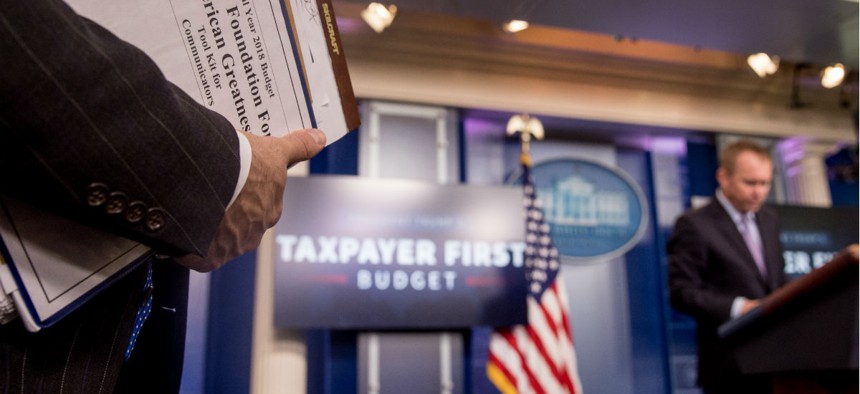
White House Budget Director Mick Mulvaney says the administration's budget puts taxpayers first. AP Photo/Andrew Harnik
Trump Proposes Easier Firing, Job Cuts at Most Agencies
Budget blueprint pushes sweeping changes to agency structures and personnel management.
President Trump, in his fiscal 2018 budget released Tuesday, proposed slashing workforce rolls at nearly every federal agency and making it easier to fire poor performers.
The blueprint would shed a net of just 1,000 federal workers next year, but that's only because larger reductions at most agencies would be offset with 25,000 jobs added at the departments of Defense, Homeland Security and Veterans Affairs. All other agencies, which would see their discretionary budgets reduced by $54 billion in fiscal 2018 and $1.4 trillion over the next decade, would see their workforces cut by 3 percent next year.
The cuts are part of the administration’s effort to “align the workforce to meet the needs of today and the future rather than the requirements of the past.” While Congress will have final control over spending levels, agencies have already begun planning for their reduced budget levels and are in the process of drafting and implementing both near-term and long-term plans to slash their workforces. The White House described those plans as fundamental for agencies to become leaner and more efficient, improve their service delivery and remove barriers preventing front-line federal employees from doing their jobs.
Some of those feds, however, are likely to become casualties of the forthcoming changes. (See our chart detailing the number of employees cut from each agency under the budget proposal.)
“As agencies are fundamentally rethinking missions and operations, these proposals may alter the composition of skills necessary for the workforce of the future,” the White House said in a section of the budget titled “Strengthening the Federal Workforce.”
Agencies have operated on autopilot for too long, the administration argued in its budget, which it said hurts both federal employees and the citizens they serve.
“Despite growing citizen dissatisfaction with the cost and performance of the federal government, too often the focus has been on creating new programs instead of eliminating or reforming ineffective programs,” the White House said. “The result has been too many overlapping and outdated programs, rules, and processes, and federal employees stuck in a system that is not working.”
Part of those outdated rules and processes are those that govern the federal personnel system, the administration explained in the budget. This has created a “seemingly intractable problem” in which top performers are not properly rewarded and poor performers are not dealt with at all. To address this issue, the White House demanded all agencies review their performance management policies, train managers on dealing with performance and conduct issues and create a mechanism providing them with real-time guidance on the tools they have available to handle the bad apples. Additionally, agencies must “eliminate non-statutory barriers to removing” employees who do not improve their performance after receiving warnings.
“Managers spend a disproportionate amount of time addressing these individuals while the rest of the team must work harder to accomplish their mission,” the White House said. “Freeing the managers and employees from the extra burden will allow more time and resources to developing and rewarding the rest of the workforce.”
As some in Congress have sought to hasten the federal disciplinary process legislatively, others—including congressional Democrats, federal employee unions, good-government groups and the Merit Systems Protection Board—have argued that managers simply need to be better trained and held accountable for their supervisory responsibilities.
The administration vowed to continue to address the issue in the future, saying it would evaluate both internal policies that should be changed as well as legislative fixes. It will analyze the Federal Employee Viewpoint Survey to examine trends, while attempting to streamline byzantine personnel rules. The White House acknowledged the changes will take time, but will ultimately help “dispel the myth” that it is virtually impossible to discipline employees of the federal government.
“There is a commitment to advocating for policies to help agencies manage their workforce in a more agile manner, reducing barriers employees face in their jobs and providing flexibilities for agency leadership and management that will allow managers to adopt practices that are common in high performing organizations,” the budget document states.







